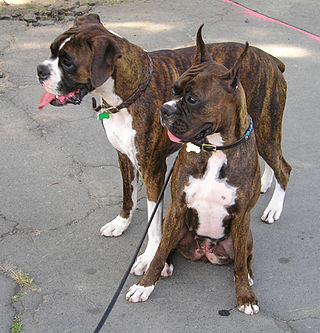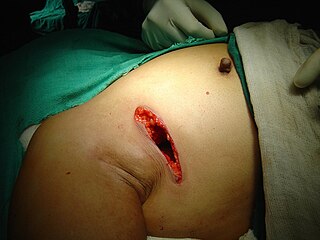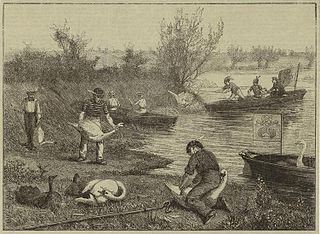
Genital modifications are forms of body modifications applied to the human sexual organs, such as piercings, circumcision, or labiaplasty.

Mutilation or maiming is severe damage to the body that has a ruinous effect on an individual's quality of life. It can also refer to alterations that render something inferior, ugly, dysfunctional, or imperfect. In modern times, the term has an overwhelmingly negative connotation.
Cattle mutilation is the supposed killing and mutilation of cattle under unusual, usually bloodless circumstances. This phenomenon has been claimed to have been observed among wild animals as well. Worldwide, sheep, horses, goats, pigs, rabbits, cats, dogs, bison, deer and elk have been reported mutilated with similar bloodless excisions; often an ear, eyeball, jaw flesh, tongue, lymph nodes, genitals and rectum are removed.
Animal euthanasia is the act of killing an animal humanely, most commonly with injectable drugs. Reasons for euthanasia include incurable conditions or diseases, lack of resources to continue supporting the animal, or laboratory test procedures. Euthanasia methods are designed to cause minimal pain and distress. Euthanasia is distinct from animal slaughter and pest control.

Docking is the removal of portions of an animal's tail. While docking and bobbing are more commonly used to refer to removal of the tail, the term cropping is used in reference to the ears. Tail docking occurs in one of two ways. The first involves constricting the blood supply to the tail with a rubber ligature for a few days until the tail falls off. The second involves the severance of the tail with surgical scissors or a scalpel. The length to which tails are docked varies by breed, and is often specified in the breed standard.

Myiasis, also known as flystrike or fly strike, is the parasitic infestation of the body of a live animal by fly larvae (maggots) that grow inside the host while feeding on its tissue. Although flies are most commonly attracted to open wounds and urine- or feces-soaked fur, some species can create an infestation even on unbroken skin and have been known to use moist soil and non-myiatic flies as vector agents for their parasitic larvae.
Mulesing is the removal of strips of wool-bearing skin from around the breech (buttocks) of a sheep to prevent the parasitic infection flystrike (myiasis). The wool around the buttocks can retain feces and urine, which attracts flies. The scar tissue that grows over the wound does not grow wool, so is less likely to attract the flies that cause flystrike. Mulesing is a common practice in Australia for this purpose, particularly on highly wrinkled Merino sheep. Mulesing is considered by some to be a skilled surgical task. Mulesing can only affect flystrike on the area cut out and has no effect on flystrike on any other part of the animal's body.

Onychectomy, popularly known as declawing, is an operation to remove an animal's claws surgically by means of the amputation of all or part of the distal phalanges, or end bones, of the animal's toes. Because the claw develops from germinal tissue within the third phalanx, amputation of the bone is necessary to fully remove the claw. The terms onychectomy and declawing imply mere claw removal, but a more appropriate description would be phalangectomy, excision of toe bone.

Lumpectomy is a surgical removal of a discrete portion or "lump" of breast tissue, usually in the treatment of a malignant tumor or breast cancer. It is considered a viable breast conservation therapy, as the amount of tissue removed is limited compared to a full-breast mastectomy, and thus may have physical and emotional advantages over more disfiguring treatment. Sometimes a lumpectomy may be used to either confirm or rule out that cancer has actually been detected. A lumpectomy is usually recommended to patients whose cancer has been detected early and who do not have enlarged tumors. Although a lumpectomy is used to allow for most of the breast to remain intact, the procedure may result in adverse affects that can include sensitivity and result in scar tissue, pain, and possible disfiguration of the breast if the lump taken out is significant. According to National Comprehensive Cancer Network guidelines, lumpectomy may be performed for ductal carcinoma in situ (DCIS), invasive ductal carcinoma, or other conditions.
Devocalization is a surgical procedure where tissue is removed from the vocal cords.

Pinioning is the act of surgically removing one pinion joint, the joint of a bird's wing farthest from the body, to prevent flight. Pinioning is often done to waterfowl and poultry. It is not typically done to companion bird species such as parrots. This practice is unnecessary and restricted in many countries.
Horse-ripping, or horse slashing, is an animal cruelty phenomenon involving serious injuries in horses, often involving mutilation of their genitalia and slashing of the flank or neck. It has not been established, however, how often these injuries are caused by human cruelty. "Horse-ripping" is not an entirely neutral term since it implies there is always a human act behind the mutilations.

Veterinary dentistry is the field of dentistry applied to the care of animals. It is the art and science of prevention, diagnosis, and treatment of conditions, diseases, and disorders of the oral cavity, the maxillofacial region, and its associated structures as it relates to animals.

Veterinary surgery is surgery performed on animals by veterinarians, whereby the procedures fall into three broad categories: orthopaedics, soft tissue surgery, and neurosurgery. Advanced surgical procedures such as joint replacement, fracture repair, stabilization of cranial cruciate ligament deficiency, oncologic (cancer) surgery, herniated disc treatment, complicated gastrointestinal or urogenital procedures, kidney transplant, skin grafts, complicated wound management, and minimally invasive procedures are performed by veterinary surgeons. Most general practice veterinarians perform routine surgeries such as neuters and minor mass excisions; some also perform additional procedures.
Docking is the intentional removal of part of an animal's tail or, sometimes, ears. The term cropping is more commonly used in reference to the cropping of ears, while docking more commonly—but not exclusively—refers to the tail; the term tailing is used, also. The term has its origins in the living flesh of the tail, commonly known as the dock, from which the animal's tail hairs grow.

Dehorning is the process of removing the horns of livestock. Cattle, sheep, and goats are sometimes dehorned for economic and safety reasons. Disbudding is a different process with similar results; it cauterizes and thus destroys horn buds before they have grown into horns. Disbudding is commonly performed early in an animal's life, as are other procedures such as docking and castration. In some cases, it can be unnecessary.
A venomoid is a venomous snake that has undergone a surgical procedure to remove or inhibit its production of venom. This procedure has been used for venomous snakes kept as pets or used in public demonstrations in order to remove the risk of injury or death when handled. The removal of venom glands or fangs of exhibited animals may be by surgery or simple mutilation; some or all of these procedures have been considered illegal and unethical. Removal of fangs is uncommon, as snakes frequently regenerate teeth, and the more invasive procedure of removing the underlying maxillary bone would be fatal. Most venomoid procedures consist of either removing the venom gland itself, or severing the duct between the gland and the fang. However, the duct and gland have been known to regenerate, and supposedly "safe" snakes have killed mice and successfully envenomated humans.

Cropping is the removal of part or all of the external flaps of an animal's ear. The procedure sometimes involves bracing and taping the remainder of the ears to train them to point upright. Almost exclusively performed on dogs, it is an old practice that was once done for perceived health, practical or cosmetic reasons. Veterinary science states there is no medical or physical advantage to the animal from the procedure, leading to concerns of animal cruelty over performing unnecessary surgery on animals. In modern times, cropping is banned in many nations, but is still legal in a limited number of countries. Where permitted, it is seen only in certain breeds of dog, such as pit bull and bull terrier type breeds, the Doberman Pinscher, Schnauzer, Great Dane, Boxer and Cane Corso.

Dubbing is the procedure of removing the comb, wattles and sometimes earlobes of poultry. Removing the wattles is sometimes called "dewattling".

Freeze branding is a technique involving a cryogenic coolant instead of heat to produce permanent marks on a variety of animals.












